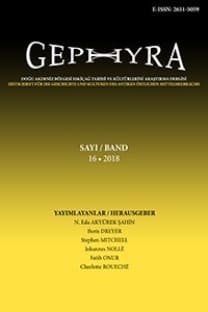Asklepios rahibi P. Claudius Calpurnianus’un onurlandırma yazıtını taşıyan bir heykel kaidesi
Asklepios rahibi, Hadrianus rahibi, Nikaia, İznik, İ. S. 120 depremi, “kurtarıcı” Asklepios
A statue base with honorary inscription for P. Claudius Calpurnianus, the priest of Asclepius
priest of Asclepius priest of Hadrian, earthquake 120 AD, Asclepius “the saviour”, Nicaea, İznik, Asclepius “the saviour”,
___
- S. Aybek – B. Dreyer, Der Archäologische Survey von Apollonia am Rhyndakos beim Uluabat–See und in der Umgebung Mysiens, in der Nordwest–Türkei 2006–2010, Orient und Okzident 2, Berlin 2016.
- S. Aybek – B. Dreyer – C. Sponsel, Der Kultplatz des Zeus Krezimos in Metropolis in Ionien, Gephyra 15, 2018, 71-94.
- H. Boyana, Nikaia Kenti ve Asklepios Kültü, in: Uluslararası Çoban Mustafa Paşa ve Kocaeli Tarihi-Kültürü Sempozyumu Bildirileri 4, Kocaeli Büyükşehir Belediyesi, 2018, 117-129.
- T. Corsten, Names in -ιανος in Asia Minor. A preliminary study, in: E. Matthews – R. W. V. Catling – F. Marchand – M. Sasanow (edd.), Onomatologos. Studies in Greek personal names presented to Elaine Matthews, Oxford 2010, 456-463.
- B. Dreyer – H. Engelmann, Neue Dokumente zum Kult des Ares in Metropolis, ZPE 168, 2009, 161-176.
- S. Eyice, İznik (Nicaea) Tarihçesi ve Eski Eserleri, İstanbul 1991.
- H. ‐F. Fernoux, Notables et élites des cités de Bithynie aux époques hellénistique et romaine, (IIIe s. av.‐IIIe s. ap.J.‐C.). Essai d'histoire sociale, Lyon 2004.
- O. Gülbay, Anadolu’da Hadrianus Dönemi İmar Faaliyetleri, İstanbul 2015.
- Th. Corsten – R. W. V. Catling – M. Ricl, A Lexicon of Greek Personal Names V A. Coastal Asia Minor: Pontos to Ionia, Oxford 2010.
- S. R. F. Price, Rituals and Power. The Roman Imperial Cult in Asia Minor, Cambridge 1984.
- F. Steger, Asklepios. Medizin und Kult, Stuttgart 2016.
- S. Şahin, Bithynische Studien [Inschriften griechischer Städte in Kleinasien 7], Bonn 1978.
- S. Şahin, Katalog der Antiken Inschriften des Museums von Iznik (Nikaia) / İznik Müzesi Antik Yazıtlar Kataloğu [Inschriften griechischer Städte in Kleinasien 10/1], Bonn 1981.
- S. Şahin, İznik (Nicaea) in Hellenistic and Roman Periods, in: I. Akbaygil – H. İnalcık – O. Aslanapa (edd.), İznik throughout History, İstanbul 2003, 3-23.
- E. Thraemer, Asklepios 2, in: RE II/2, 1896, 1642-1697.
- ISSN: 1309-3924
- Yayın Aralığı: Yılda 2 Sayı
- Başlangıç: 2004
- Yayıncı: Nalan Eda AKYÜREK ŞAHİN
Roma İmparatorluğu'nda yenilikler ve ekonomik gelişim
Lydia Hinterlandında Skylla Ne Arıyor? Philadelphia ve Smyrna’nın Bir Homonoia Sikkesi Üzerine
19. yüzyıla kadar Küçük Asya’daki erken dönem antika meraklıları hakkında
Terrance Michael Patrick DUGGAN
Asklepios rahibi P. Claudius Calpurnianus’un onurlandırma yazıtını taşıyan bir heykel kaidesi
Aygün EKİN MERİÇ, Boris DREYER
Bursa Müzesi'nden yeni yazıtlar
Nalan Eda AKYÜREK ŞAHİN, Hüseyin UZUNOĞLU
